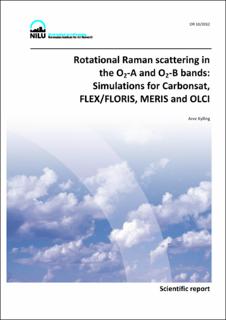Rotational Raman scattering in the O2-A and O2-B bands: simulations for Carbonsat, FLEX/FLORIS, MERIS and OLCI.
Research report
Permanent lenke
https://hdl.handle.net/11250/2718812Utgivelsesdato
2012Metadata
Vis full innførselSamlinger
Sammendrag
Rotational Raman scattering (RRS) causes filling-in of absorption lines in Earth shine spectra. It is routinely accounted for in analysis of UV and visible spectra measured both by satellite and ground-based instruments. RRS is also present at longer wavelengths, however, the magnitude generally decreases with increasing wavelength due to decrease in the scattering cross section. For high-resolution spectral measurements the effect may be noticeable. Depending on the application, RRS thus needs to be quantified and possibly corrected for. Of special interest is the effect of RRS in the O2-A (759-769 nm) and O2-B (686-697 nm) bands. Here, the effect of RRS in these bands is studied for the present and future satellite instruments CarbonSat, FLEX/FLORIS, MERIS and OLCI.
